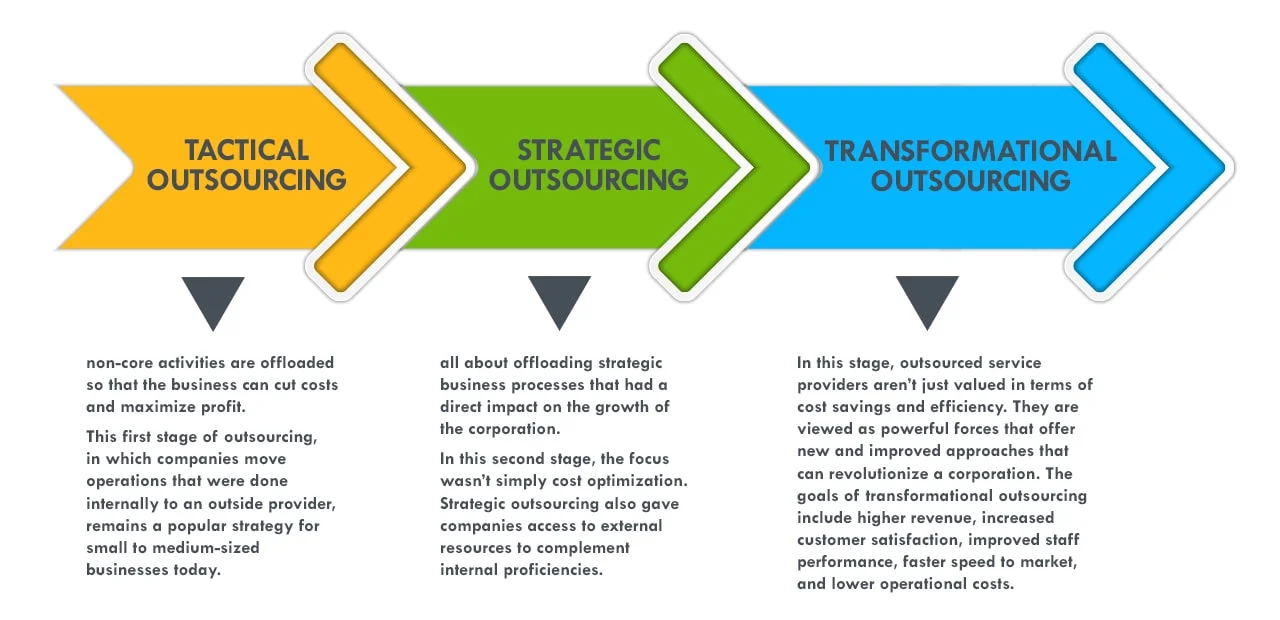Outsourcing Remote Work: History, Evolution, and Outlook

Outsourcing has become so prevalent that it’s hard to imagine a world without it. And yet it wasn’t even considered a viable business strategy until the 1980s and didn’t become commonplace until the giant leap in internet technology in the 1990s and early 2000s.
Today, the global outsourcing market is massive. In 2019, it amounted to a staggering $92.5 billion, with information technology outsourcing making up the bulk of the industry’s global revenue.
The top reason for remote subcontracting is for businesses to cut costs. It also allows companies to focus resources on core functions, redeploy in-house talent to more strategic tasks, and solve capacity issues.
With COVID-19 disrupting supply chains, changing customer habits, and making flexible work arrangements essential, contracting out work to independent, fully remote individuals or teams has become more important than ever. Consequently, companies need to have a better understanding of contracting and remote jobs. This includes knowing outsourcing’s benefits and challenges and how to utilize it better.
Take a look at how the outsourcing movement started, how it has affected businesses around the world, and what the future looks like for it.
Outsourcing vs. remote staffing vs. offshoring
While discussing the evolution, impact, and future of outsourcing, you will come across words that are often used interchangeably but mean very different things. Before delving into the intricacies of outsourcing, it’s important to define a few key terms.

-
Outsourcing
Outsourcing is when a company hires another company or an individual to perform certain duties that could be or have usually been done in-house. The word is frequently used as a synonym for subcontracting.
-
- Onshore outsourcing is when outsourced work is performed locally, e.g. when a Canadian public relations firm hires graphic designers located in Canada.
- Nearshore outsourcing or nearshoring is when a company offloads work to another country that is in roughly the same time zone, e.g. when a clothing company in New York City outsources manufacturing to a third-party service provider in Mexico.
- Offshore outsourcing or offshoring is when work is outsourced to a distant country, e.g. when an airline company in the UK has an IT agency in Vietnam handle its website development and maintenance.
-
Business process outsourcing
Business process outsourcing is the method of hiring another company to perform the operations of a non-primary business process. These are usually customer service or administrative tasks but may also include marketing, software development, recruitment, and other essential services.
-
Remote staffing
Remote staffing is simply the process of hiring staff members who don’t work at an office. It is also the default work arrangement for remote-first companies. Unlike outsourced workers, who are not part of your company and are managed through an external service provider, remote staff are part of your existing team and are managed by you. The only difference between remote staff and in-office staff is that the former is location-independent.
-
Virtual assistants
Virtual assistants or VAs are skilled individuals who provide a variety of business support services and work remotely. VAs are especially helpful for entrepreneurs looking to offload repetitive work such as customer support, data entry, and online store management. They’re also a valuable resource for business owners who need help with creative or highly technical tasks like app development or digital marketing. Virtual assistants are either hired through a remote staffing provider or recruited through online direct sourcing platforms.
-
Telework
Telework or telecommuting is a work arrangement that enables employees to work from anywhere they want. Teleworkers or remote workers use computers, phones, and other tools to communicate and collaborate with coworkers and clients. This set-up is also known as work from home (WFH), remote work, and mobile work.
How outsourcing started
The word “outsourcing” is typically associated with tasks that are performed in front of a computer or done using special equipment, but this business strategy has been around for a very long time. While it’s difficult to trace the first evidence of outsourcing, the simple act of delegating work to others has been taking place for thousands of years.
Before there was outsourcing, individuals and families were essentially self-sufficient. They built their own homes, foraged their own food, and made their own clothing.
Eventually, villages began to spring up and people started to develop certain professions. When someone didn’t have the ability or the skills to do certain types of work, those tasks had to be outsourced to people who could do them. Think of the farmer hiring farmhands to help bring in the harvest or the ship captain hiring seafarers to crew a vessel.
The bartering system allowed these workers to receive compensation for the goods they produced or the services they rendered. Essentially, these individuals were doing outsourced work for others in the community.
Migration was another leading driver behind outsourcing. It gave industrial leaders a greater diversity of skills and labor rates with which to grow economies. But it wasn’t until the Industrial Revolution that outsourcing began to change the way companies did business.
The Industrial Revolution
Before the Industrial Revolution, companies were mostly independent. Business owners preferred to build and manage their own teams instead of getting the expertise they needed from outside the company. They employed workers for manufacturing, distribution, accounting, administrative work, and even for the construction of offices and factories.
During the Industrial Revolution, technological advancements allowed businesses to produce en masse. However, manufacturing large quantities of products also prompted labour costs to skyrocket.
To reduce operational expenses, business owners began to outsource the less-than-essential functions instead of keeping them in-house. This led to the proliferation of businesses such as insurance companies, accounting firms, and distributors servicing multiple clients in the same city or region. The invention of the telegraph made remote communication easier and paved the way for outsourcing across significant distances.
1970s to 1990s
It wasn’t until the 1970s that the term “outsourcing” was used to describe the method of hiring outside firms to manage non-core business processes. And it wasn’t until 1989 that outsourcing was recognized as a legitimate business strategy.
By this point, companies weren’t just outsourcing for business processes that they had no internal competency for. Large companies that were attempting to compete globally had identified the value of outsourcing the production of goods to countries where labour was cheaper. It became common for manufacturers to outsource the production of both low-tech items (clothes, toys, and accessories) and high-tech items (consumer electronics and appliances) to the East.
Offshoring was made possible by massive improvements in infrastructure, which drove transportation costs down. Governments in developing nations had also begun to invest in education and skills training, ensuring that local workers could provide quality services. American enterprises were also drawn by lower labour costs and more lenient rules regarding employee wages and benefits.
As outsourcing started to become more popular, companies moved from offshoring the production of goods and the functions they couldn’t do in-house to outsourcing basic support services. They began hiring service providers to perform critical business functions like billing, human resources, tax services, mail distribution, word processing, and database management.
Outsourcing the production of goods and the essential but routinely tasks allowed companies to focus on main objectives like customer service and branding.
The tech industry was one of the first to start outsourcing support services like payroll processing, data transcription, and customer service. This coincided with the opening up of economies in developing nations, the widespread adoption of the internet, and the continued investment in IT infrastructure.
Since the 1990s, countries like India and the Philippines, where workers are fluent in English and are typically college-educated, started to attract companies seeking to keep operational costs manageable. As of 2019, India still holds the top spot in the list of digital nations compiled yearly by Tholons. Brazil, the Philippines, and Mexico have also consistently placed in the top 10.
The evolution of outsourcing
The outsourcing industry has grown and evolved rapidly, creating new areas of opportunity for organizations around the world. The evolution of outsourcing can be divided into three key levels:

-
Tactical outsourcing
In tactical or traditional outsourcing, non-core activities are offloaded so that the business can cut costs and maximize profit. This first stage of outsourcing, in which companies move operations that were done internally to an outside provider, was widely practised in the 1980s and remains a popular strategy for small to medium-sized businesses today.
Companies that engage in tactical outsourcing are usually those that are experiencing a scarcity in financial resources, difficulty obtaining needed talent, or issues with managerial competence. At this level, the goals are simple. Relationships with outsourcing suppliers are designed to generate cost savings as quickly as possible, eliminate the burden of staffing, and reduce management time.
-
Strategic outsourcing
Over time, corporations began to rethink and seek more from their outsourcing relationships. Strategic outsourcing, a business term that became popular in the 1990s to 2000s, was all about offloading strategic business processes that had a direct impact on the growth of the corporation.
In this second stage, the focus wasn’t simply cost optimization. Strategic outsourcing also gave companies access to external resources to complement internal proficiencies. This allowed businesses to improve internal processes and gave them a strategic advantage.
As a consequence, the scope of the service provider’s involvement and the length of the relationship with the business grew significantly. Instead of outsourcing business functions to a large number of vendors, companies started working with fewer suppliers, choosing the ones that can offer the best results.
In this level of outsourcing, the relationship between the corporation and the service provider is no longer simply that of a buyer and a supplier. The two become strategic partners, forming a long-term business relationship that is mutually beneficial to both.
-
Transformational outsourcing
While strategic outsourcing was about redefining the corporation’s relationship with service providers, the third stage went a step further. In The Black Book of Outsourcing, authors Douglas Brown and Scott Wilson wrote that the focus of transformational outsourcing is redefining the business itself.
In the 2000s, the global economic climate had forced corporations to recognize that in order to survive, they must usher in a new business model. Transformational outsourcing became the answer.
Business executives began to reconsider how they utilized the power of outsourcing and realized that outside specialists offered competencies and innovations that could transform companies. External expertise could enable companies to satisfy their rapidly changing business needs, optimize their operations, and compete for market and mind share.
In this stage, outsourced service providers aren’t just valued in terms of cost savings and efficiency. They are viewed as powerful forces that offer new and improved approaches that can revolutionize a corporation. The goals of transformational outsourcing include higher revenue, increased customer satisfaction, improved staff performance, faster speed to market, and lower operational costs.
From freelancers to remote staffing
Just as the scope of outsourcing has evolved over the years, so has its face. When people spoke about outsourcing in previous decades, the image that came to mind was that of either cafe-frequenting freelancers or BPO workers packed in call centers.
In the early 2000s, a new breed of outsourced workers emerged to become a crucial part of the outsourcing industry. Virtual employees or virtual assistants are highly trained individuals who are hired to work on running projects or to provide long-term services. Unlike freelancers, who usually only work on short-term projects, these handpicked workers become part of the company and work closely with other staff members.
Virtual assistants allow businesses to benefit from a remote staffing arrangement. In this set-up, corporations have access to external expertise without having to go through the hassle of recruitment. It also enables them to expand without spending money on office space, equipment, maintenance and security, taxes, and other expenses related to having on-site employees.
Statistics from the United States Census Bureau show the growing popularity of remote staffing. In 2010, census data showed that more than 59% of those who worked from home worked for a private company while 45% were freelance.
Whether they are freelancers or work as remote staff, it’s clear that teleworkers are here to stay. By 2018, 70% of the global population had been working outside the office at least once a week. Over half reported that they did remote work for at least half the week.
More recently, the coronavirus pandemic created a remote work tipping point, forcing millions of previously on-site employees to adapt to a teleworking set-up. It also compelled business executives to acknowledge the value of remote work in terms of business continuity, employee satisfaction, and cost optimization. We have entered a new era where telecommuting is an essential part of workers’ daily lives instead of simply being an option offered by a handful of companies.
The state of outsourcing today
Aside from enabling companies to drastically reduce operational costs, outsourcing remote staff also allows them to:
- Gain access to a global talent pool of skilled professionals
- Reallocate available internal resources to where they’re most urgently needed
- Improve efficiency, operations, and cycle times
- Focus on business development and core functions
- Share risks with a strategic partner
- Improve customer service
- Accelerate organizational transformation
According to a 2016 global outsourcing survey by Deloitte, 59% of companies who outsource use it as a cost-cutting tool. 57% outsource because it enables them to focus on core business while 47% do so because it allows them to solve capacity issues.

Most of those who participated in the survey represented companies in the information technology, finance, and HR sectors. 67% of respondents were from IT companies, reflecting data that shows most outsourced jobs are in information technology.
Of the outsourcing industry’s $92.5 billion global revenue in 2019, $66.52 billion was generated by information technology outsourcing and $26 billion came from business process outsourcing.
Apart from IT and business processes, other prominent segments in the global outsourcing industry include healthcare, media, travel, energy, retail, transport, and telecommunications. Outsourcing is also prevalent in the banking industry. According to Credit Donkey, banks outsource nearly 40% of all help desk jobs, along with more than a third of all positions in payroll and benefits administration.
The United States is currently the biggest contractor in the global outsourcing market. In 2017, most outsourcing deals — a whopping 84.2% — came from the US. To see just how huge that slice is, think about the fact that the second biggest contributor, the United Kingdom, contributed a mere 5.2% of the whole market. Apart from the US and the UK, Spain and Australia are also considered major outsourcing markets.
In 2017, the top two consumers of outsourced services in North America were the government and defence sectors, specifically those in the United States and Canada. According to KPMG, 39% of the total value of outsourcing deals signed that year came from the defence sector while 29% came from the government sector.
While the outsourcing activities of the United States have risen, jobs are also coming into the US from other countries. The Bureau of Economic Analysis reports that 6.8 million American workers were employed by foreign-owned companies in 2015. According to the Pew Research Center, this was a 22% increase from 2007, which is significantly larger than the 3.6% overall growth of US private employment over the same timespan.
The average annualized contract value (ACV) in the global outsourcing industry was $32.6 million in 2017. This was a 53% increase from the average ACV of $21.3 million in 2016.
Despite these figures, outsourcing isn’t limited to large firms and government offices. According to a 2018 survey by Clutch, more than a third (37%) of small businesses were already outsourcing a business process. The survey also found that more than half (52%) intended to outsource in 2019.
Survey respondents said that they outsource to increase efficiency, get help from outside experts, and increase flexibility. The most commonly outsourced duties were accounting and finance, IT services, and digital marketing. Small businesses benefit most from outsourcing highly technical or creative tasks that are not part of the company’s core functions.
View our infographic about the current state of outsourcing remote work here.
The future of outsourcing
Outsourcing has reshaped the global economy and will continue to do so. Companies will always be on a quest to reduce expenses, maximize revenue, and stay competitive. Outsourcing is a cost-effective and time-tested way to achieve all this.
In addition, as the world becomes more dependent on cloud computing and artificial intelligence, companies will continue to rely on outsourcing providers that can help them adopt new technologies. As long as outsourcing providers are able to create value for their customers and address challenges that crop up, companies will continue to outsource.
So how do businesses feel about their outsourcing providers?
Based on surveys conducted over the last decade, organizations that outsource intend to continue doing so. In the Deloitte survey, 78% of respondents said that they felt positive about their relationship with outsourcing service providers. In a 2016 study, 65% of companies that outsource app hosting said that they plan on increasing the amount of work that they outsource.
Following the Great Recession, only about 9% of businesses stopped their outsourcing activities. In fact, during this period, 57% of companies decided to increase their outsourcing activities, showing outsourcing’s strength as a business model, especially during times of crisis.
Business owners can no longer ignore the fact that outsourcing is more than just a fad. Today, it is a vital business model that enables companies to stay competitive on the world stage and to stay afloat in these increasingly challenging times.
While there is legitimate concern about the effect of automation on outsourcing, studies suggest that it will continue to be an attractive business strategy. Some jobs simply can’t be automated and are better outsourced. Experts say that the industry will respond to the threat of automation by improving the quality of the outsourcing workforce. As a result, there will also be an increase in the number of higher-level tasks that are outsourced.
Final thoughts
In the 21st century, you won’t find many products or services that have not benefited from outsourcing at some point in their production. What once was a business tactic is now an economic necessity and a cultural phenomenon.
Though there are voices raised in criticism of offshoring, it can’t be denied that it has become one of the best ways to ensure further business growth.
Outsourcing, particularly offshore outsourcing, has also enabled businesses to cross geographical and cultural boundaries and benefit from the diversity of human resources that can support our organizations. Perhaps more than just fueling businesses and economies, the real beauty of outsourcing is how it has connected and united people from all over the world.










